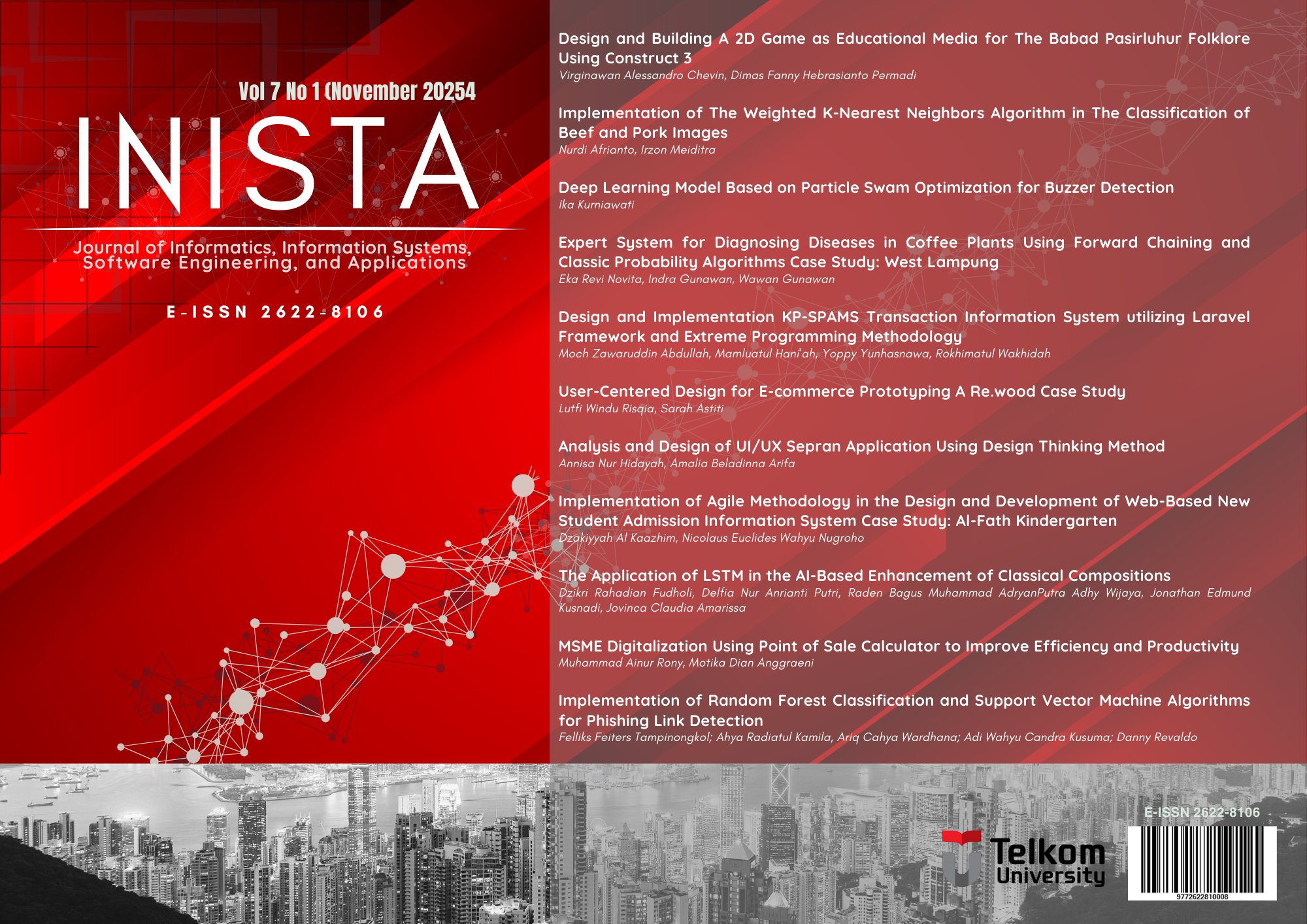User-Centered Design for E-commerce Prototyping A Re.wood Case Study
Main Article Content
Abstract
Re.wood is a wooden furniture business located in Tinggarjaya Village, Jatilawang District, Banyumas Regency that offers a variety of furniture products, ranging from chairs to wall hangings, to beautify interior and exterior spaces, but still has a limited market share. Re.wood currently uses a conventional sales process that is less effective and lacks information for customers, which causes a lack of sales levels for Re.wood. Designing a system before entering the system development stage is a must because it ensures that the resulting solution is relevant and effective in overcoming the problems users face. The problem can be solved by designing User Interface and User Experience of web-based e-commerce applications. The design method used by researchers is the user-centered design method. User-centered design is a method of focusing on the needs of potential users in the system design stage or process. The results of designing the user interface and user experience only include the user interface developed using Figma. The resulting website produces menus such as Home Page, login, Shop, Cart, Search, and Profile. This evaluation utilized the User Experience Questionnaire (UEQ) methodology to assess various aspects of the system. The resulting values (1.55 for Efficiency, 1.54 for Attractiveness, 1.49 for Clarity, 1.33 for Accuracy, 1.5 for Stimulation, and 1.15 for Novelty) represent the average UEQ calculation figures for each dimension. In other words, these numbers correspond to the results obtained through the UEQ, which helps evaluate user experience in terms of efficiency, attractiveness, clarity, accuracy, stimulation, and novelty. UEQ uses a Likert scale to measure user experience, and the resulting values show that the system performs well in most aspects. These findings indicate that the prototype meets the needs and provides a satisfying user experience.
Article Details

This work is licensed under a Creative Commons Attribution-ShareAlike 4.0 International License.
Authors who publish with this journal agree to the following terms:
- Authors retain copyright and grant the journal right of first publication with the work simultaneously licensed under a Creative Commons Attribution License (CC BY-SA 4.0) that allows others to share the work with an acknowledgement of the work's authorship and initial publication in this journal.
- Authors are able to enter into separate, additional contractual arrangements for the non-exclusive distribution of the journal's published version of the work (e.g., post it to an institutional repository or publish it in a book), with an acknowledgement of its initial publication in this journal.
- Authors are permitted and encouraged to post their work online (e.g., in institutional repositories or on their website) prior to and during the submission process, as it can lead to productive exchanges, as well as earlier and greater citation of published work.
References
[2] Z. A. Hasibuan and Nurbaiti, “Strategi Penggunaan Sistem Informasi Dalam Komunikasi Bisnis Secara Elektronik,” J. Ekon. Dan Bisnis Digit., vol. 01, no. 02, pp. 94–99, 2023.
[3] I. Rochmawati, “Analisis User Interface Situs Web iwearup.com.,” Visualita, vol. 7, no. 2, p. 14, 2019.
[4] P. Aprilia, “fungsi UI .pdf,” 2020. https://www.niagahoster.co.id/blog/perbedaan-ui-dan-ux/ (accessed Jul. 08, 2022).
[5] N. R. Wiwesa, “User Interface dan User Experience Untuk Mengelola Kepuasan Pelanggan,” J. Sos. Hum. Terap., vol. 3, no. 2, pp. 17–31, 2021.
[6] N. S. Paramita, H. M. Az-zahra, and D. Priharsari, “Analisis Pengalaman Pengguna Pada Aplikasi Dompet Digital Dengan Metode UX Curve ( Studi Kasus : OVO ),” vol. 5, no. 6, pp. 2231–2242, 2021.
[7] A. Steffie and A. Kusnawan, “Pengaruh Kemudahan Penggunaan, Pengalaman Pengguna dan Kepuasan Pelanggan terhadap Keputusan Penggunaan Berulang Shopeepay ( Studi Kasus Pada Konsumen Generasi Z ),” Emabi Ekon. dan Manaj. Bisnis, vol. 2, no. 1, pp. 1–9, 2023.
[8] C. Jessica, “Mengenal User Interface (UI): Arti, Mengapa Penting, Fungsi, dan Karakteristik,” glints, 2022. https://glints.com/id/lowongan/apa-itu-user-interface/#.YsgkgXZBzb1 (accessed Jul. 08, 2022).
[9] F. Guo, “More Than Usability: The Four Elements of User Experience,” UXmatters, 2012. https://www.uxmatters.com/mt/archives/2012/04/more-than-usability-the-four-elements-of-user-experience-part-i.php (accessed Aug. 13, 2022).
[10] A. B. Cavanugh, “Analisis Dan Perancangan Ui/Ux Dengan Metode User Centered Design Pada Website Dlu Ferry,” Universitas Dinamika, 2021.
[11] A. G. Hartzani, “Evaluasi User Experience Pada Dompet Digital Ovo Menggunakan User Experience Questionnaire (UEQ),” Universitas Islam Negeri Syarif Hidayatullah Jakarta, 2021.
